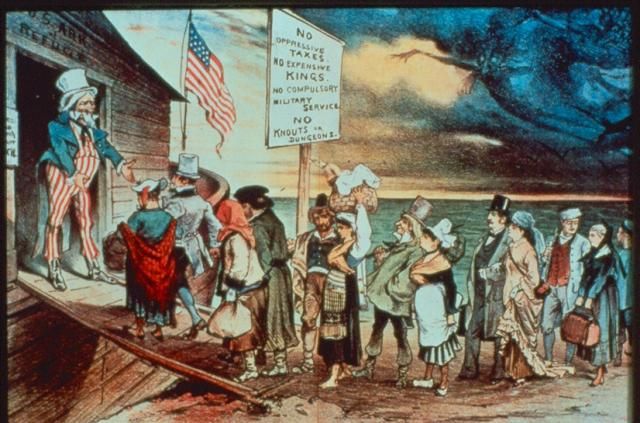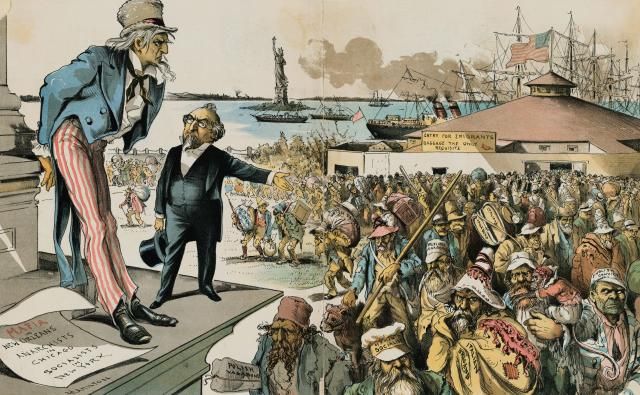 After arriving at Ellis Island, immigrants spent an average of two to five hours before getting the go-ahead to embark on a new life in the United States.
After arriving at Ellis Island, immigrants spent an average of two to five hours before getting the go-ahead to embark on a new life in the United States.Posted on 01/02/2017 6:33:33 AM PST by NYer
align:left;">These newcomers were the first to be processed at the brand-new, federal government-run facility, where a total of 12 million immigrants over 62 years were registered and then given medical and legal checks before being allowed onto the mainland.
(This was only for third-class passengers, of course—those in first and second class were given a quick inspection on the ship, then allowed to proceed to New York City.)
 After arriving at Ellis Island, immigrants spent an average of two to five hours before getting the go-ahead to embark on a new life in the United States.
After arriving at Ellis Island, immigrants spent an average of two to five hours before getting the go-ahead to embark on a new life in the United States.
Two percent, however, were turned back across the pond for a variety of reasons: bad health, mental issues, anti-American sentiment.
Capturing the faces of many of these new arrivals in their native dress was chief registry clerk Augustus Sherman, who was also an amateur photographer.
Sherman took about 250 photos of people he encountered between 1905 and the 1920s.
 “The people in the photographs were most likely detainees who were waiting for money, travel tickets or someone to come and collect them from the island,” stated The Public Domain Review.
“The people in the photographs were most likely detainees who were waiting for money, travel tickets or someone to come and collect them from the island,” stated The Public Domain Review.
Sherman took the photos for his own enjoyment. “Augustus Sherman was fascinated by where the immigrants were coming from and their traditional clothing,” states the National Park Service.
“He usually photographed immigrants that were detained briefly and used mostly dull backgrounds so the immigrants themselves were the main focus.”
 “Though originally taken for his own personal study, Sherman’s work appeared in the public eye as illustrations for publications with titles such as ‘Alien or American,’ and hung on the walls of the custom offices as cautionary or exemplary models of the new American species,” explained a summary of a book that collected Sherman’s Ellis Islands photos.
“Though originally taken for his own personal study, Sherman’s work appeared in the public eye as illustrations for publications with titles such as ‘Alien or American,’ and hung on the walls of the custom offices as cautionary or exemplary models of the new American species,” explained a summary of a book that collected Sherman’s Ellis Islands photos.
Regardless of how they were used a century ago, these photos are incredible portraits of what some of the people who made it to Ellis Island looked like.
Dressed in folk outfits from their native countries, they have unsmiling yet hopeful faces.
 For more about what it was like to arrive in New York City as an immigrant in the 19th and early 20th centuries—first at Castle Garden, then at Ellis Island—check out The Gilded Age in New York, 1870-1910.
For more about what it was like to arrive in New York City as an immigrant in the 19th and early 20th centuries—first at Castle Garden, then at Ellis Island—check out The Gilded Age in New York, 1870-1910.
[Countries of origin: 1. The Netherlands; 2. Greece; 3. Romania; 4. Italy; 5. “Hindu” is how the boy is described]
The precedent already exists to reinstate a similar policy under Pres. Trump.
The first and second class passengers just walking in unquestioned would be considered a major loophole today.
I agree. Not everything that we did a 100 years ago is worth re-instating, like this genuflection to upper class immigrants. Everyone, from serfs to Dukes, needs to be processed thoroughly.
My Napolitano, born grandfather stepped of the boat, SS Algieria, from. Naples to NY in 1906 around age 12. Others in my family made the trip in the 1890s.
That 3rd pic, she’s a cutie.
Great grandfather, Gustavus Adolphus Svenson arrived at Ellis Island in 1902. He temporarily left his wife and infant daughter back in Sweden. The Ellis authorities couldn’t put up with Gustavus Adolphus Svenson so they changed it to Gus Swanson. Gus didn’t argue, figuring it was part of becoming an American. By 1905, Gus had saved enough money from laying bricks, digging wells and mining coal to send for his wife and daughter. The daughter became my mother’s mother in the small town of Mystic, Iowa.
Have bookmarked the link for ancestry research.
Mine from Slovakia right after the wreckage of WWI.
Their jobs were maid and cook in America.
No welfare. No affirmative action. They could feed a family of six for a few dollars a week.
But it was white privilege.
The people who came in got no welfare payments, no EBT cards, no obammyphones, no lodging, no job, no English lessons. They didn’t shoot people up or set bombs.
But the politicians have abandoned their descendants, in favor of the individuals now streaming in who rape our women, burn things down, steal things, take our money, and blow people up.
Mine from Slovakia right after the wreckage of WWI.
Their jobs were maid and cook in America.
No welfare. No affirmative action. They could feed a family of six for a few dollars a week.
But it was white privilege.
I prefer the 1925 to 1965 immigration policy of limiting immigration.
Take a picture of me dealing with US government bureaucratic “formalities” and I will be far from smiling either.
My father, aged 15, arrived at Ellis Island in 1921 with his mother and sister. After processing, he told of being seated at a long wooden table eating white bread torn into pieces and soaked in a bowl of milk, I assume provided by American authorities. He and his mother and sister then proceeded by train to Chicago where they were met by my grandfather who had come to America about a decade before. He had absconded with his sister-in-law but when they separated he belatedly sent for his wife and children. My father learned English in less than a year and spoke it without a discernible accent. He loved books, bookshops, and reading, and accumulated a large book collection which he sold off during the depression to live on. That led to opening his own printing shop which he operated with my mother for the rest of his life.
there is a lot in this that is simply untrue.
Could you be more specific.
My grandfather was one of the directors of Ellis Island. He came here after deciding in the seminary he didn’t want to be a priest (first born son in family etc) and that pretty much meant goodbye. He was college educated which was rare then.

The reality

Disclaimer: Opinions posted on Free Republic are those of the individual posters and do not necessarily represent the opinion of Free Republic or its management. All materials posted herein are protected by copyright law and the exemption for fair use of copyrighted works.